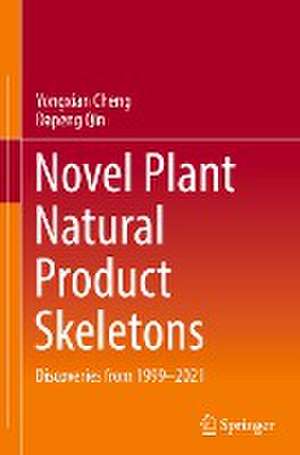Novel Plant Natural Product Skeletons: Discoveries from 1999-2021
Autor Yongxian Cheng, Dapeng Qinen Limba Engleză Hardback – 3 ian 2024
Preț: 899.21 lei
Preț vechi: 1096.60 lei
-18% Nou
Puncte Express: 1349
Preț estimativ în valută:
172.08€ • 178.64$ • 143.49£
172.08€ • 178.64$ • 143.49£
Carte tipărită la comandă
Livrare economică 22 martie-05 aprilie
Preluare comenzi: 021 569.72.76
Specificații
ISBN-13: 9789819973286
ISBN-10: 9819973287
Pagini: 344
Ilustrații: XVI, 344 p. 63 illus., 6 illus. in color.
Dimensiuni: 155 x 235 mm
Greutate: 0.68 kg
Ediția:1st ed. 2024
Editura: Springer Nature Singapore
Colecția Springer
Locul publicării:Singapore, Singapore
ISBN-10: 9819973287
Pagini: 344
Ilustrații: XVI, 344 p. 63 illus., 6 illus. in color.
Dimensiuni: 155 x 235 mm
Greutate: 0.68 kg
Ediția:1st ed. 2024
Editura: Springer Nature Singapore
Colecția Springer
Locul publicării:Singapore, Singapore
Cuprins
1. Introduction.- 2. Classification of Diverse Novel Sesquiterpenoids.- 3. Classification of Diverse Novel Diterpenoids.- 4. Diverse Novel Sesterterpenoids.- 5. Classification of Diverse Novel Triterpenoids.- 6. Classification of Diverse Novel Limonoids.- 7. Classification of Diverse Novel Phloroglucinols.- 8. Classification of Diverse Novel Meroterpenoids.
Notă biografică
Dapeng Qin was born in 1989 in Nanyang, China. He received his B.S. in 2013 (Shenyang Pharmaceutical University, Shenyang) and Ph.D. in 2018 (Jinan University, Guangzhou). He was an associate researcher of School of Pharmaceutical Sciences, Shenzhen University Health Science Center (Shenzhen), from 2018 to 2020. Now he is a postdoctoral fellow at the School of Science, Hong Kong University of Science and Technology.
Yongxian Cheng was born in 1972 in Hebi, China. He received his B.S. in 1994 (Henan University of Traditional Chinese Medicine, Zhengzhou), M.S. in 1997 (Chengdu University of Traditional Chinese Medicine, Chengdu), and Ph.D. in 2000 (Kunming Institute of Botany, Chinese Academy of Sciences, Kunming). He had his postdoctoral research experience at Peking University (2000−2002) and worked as a Humboldt research fellow in University of Jena, Germany (2003−2005). From 2008 to 2016, he has been a professor at Kunming Institute of Botany, Chinese Academy of Sciences. He moved to Shenzhen University Health Science Center in 2016, and now he is a research group leader and the dean of School of Pharmaceutical Sciences, Shenzhen University Health Science Center (Shenzhen). His research interests concern biologically active compounds from plant, animal, or mushroom origins. He has published over 300 scientific papers and applied for over 100 patents. He is the owner of several national or provincial awards.
Yongxian Cheng was born in 1972 in Hebi, China. He received his B.S. in 1994 (Henan University of Traditional Chinese Medicine, Zhengzhou), M.S. in 1997 (Chengdu University of Traditional Chinese Medicine, Chengdu), and Ph.D. in 2000 (Kunming Institute of Botany, Chinese Academy of Sciences, Kunming). He had his postdoctoral research experience at Peking University (2000−2002) and worked as a Humboldt research fellow in University of Jena, Germany (2003−2005). From 2008 to 2016, he has been a professor at Kunming Institute of Botany, Chinese Academy of Sciences. He moved to Shenzhen University Health Science Center in 2016, and now he is a research group leader and the dean of School of Pharmaceutical Sciences, Shenzhen University Health Science Center (Shenzhen). His research interests concern biologically active compounds from plant, animal, or mushroom origins. He has published over 300 scientific papers and applied for over 100 patents. He is the owner of several national or provincial awards.
Textul de pe ultima copertă
This book provides an overview of the new plant natural product skeletons discovered from 1999 to 2021. It categorizes these natural products by providing their names, source distributions, structural types, structure characteristics, and bioactivities. A total of 1373 plant products in 99 families are presented, which cover 36 different structure types within the Hypericaceae family of which the majority are alkaloid structures. In addition, it presents the biological profiling in the last 23 years by summarizing the biological activities and potential disadvantages. The new natural products skeleton presented are unprecedented structural scaffolds and could bring new opportunities for biological/pharmaceutical areas and provide new structure templates for synthetic chemists. This book helps readers gain in-depth insight into the past and recent trends of natural products; it also assists those interested in assessing the potential biological function of the natural products.
Caracteristici
Provides comprehensive overview of new skeleton compounds from plant Presents structural characteristics and biological activities of plant natural products Offers tool to identity complex natural products targets
